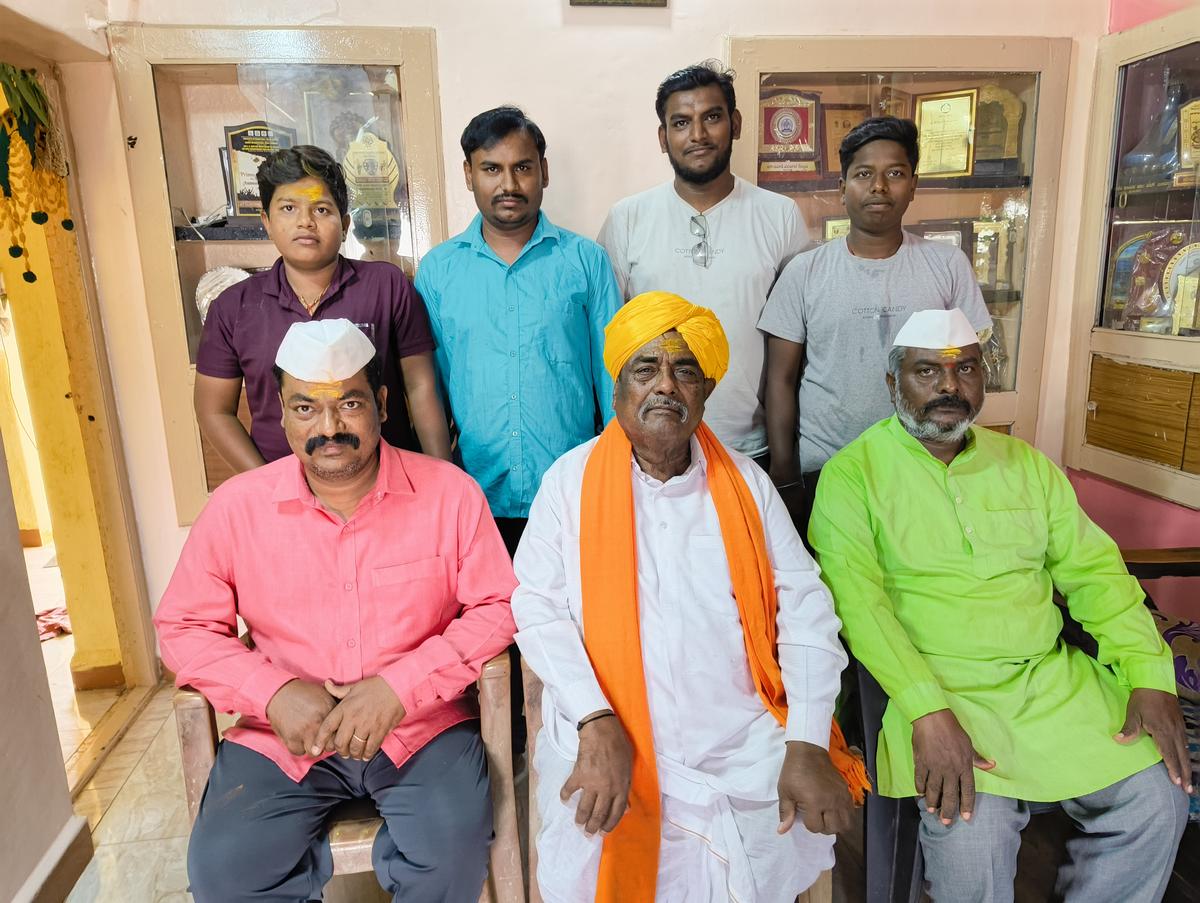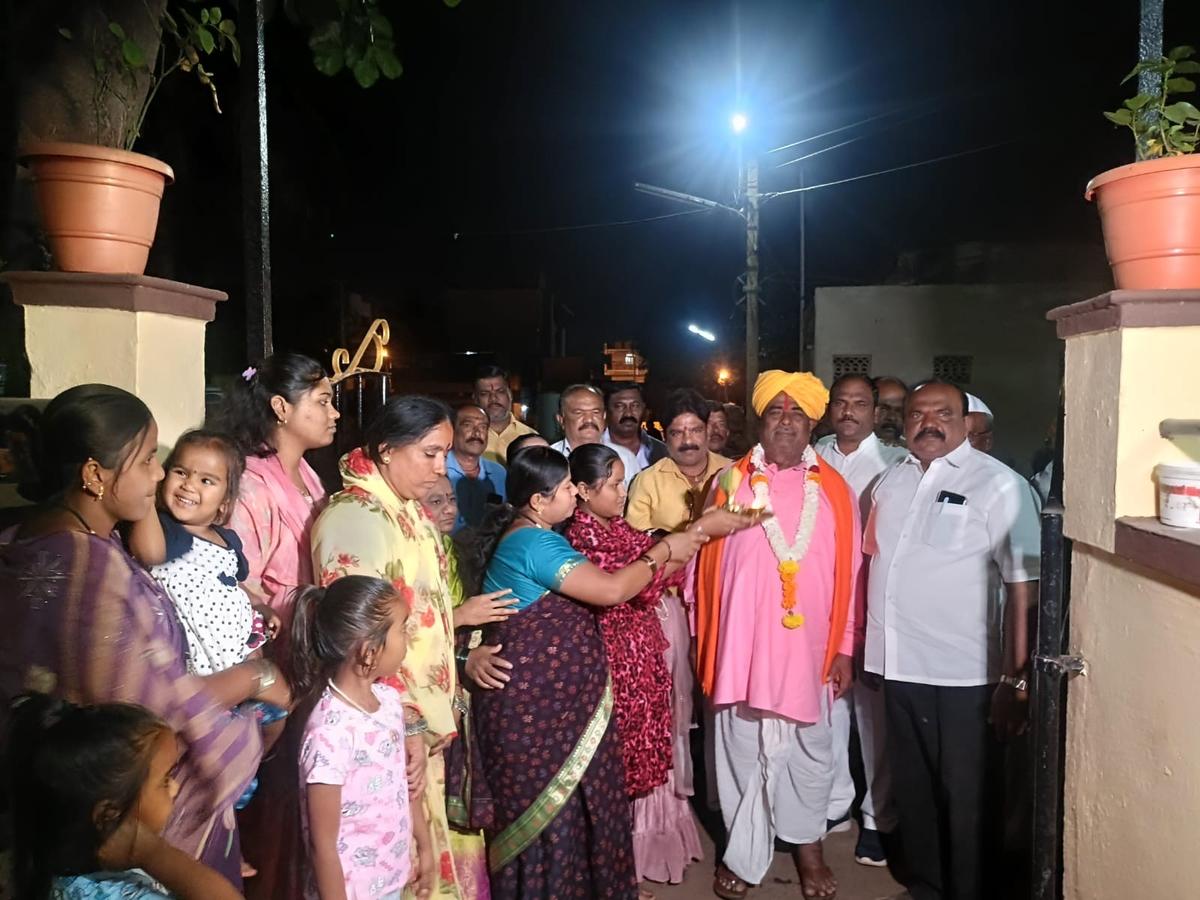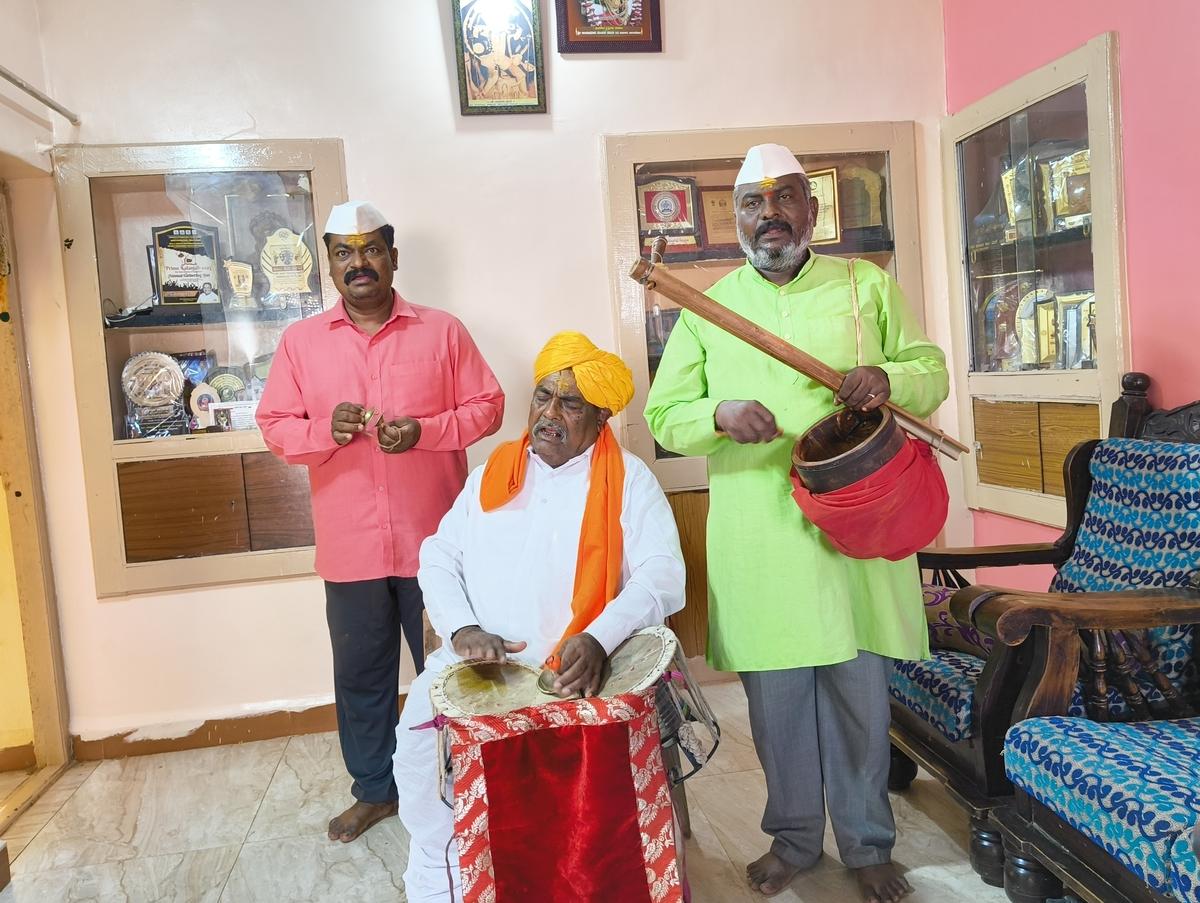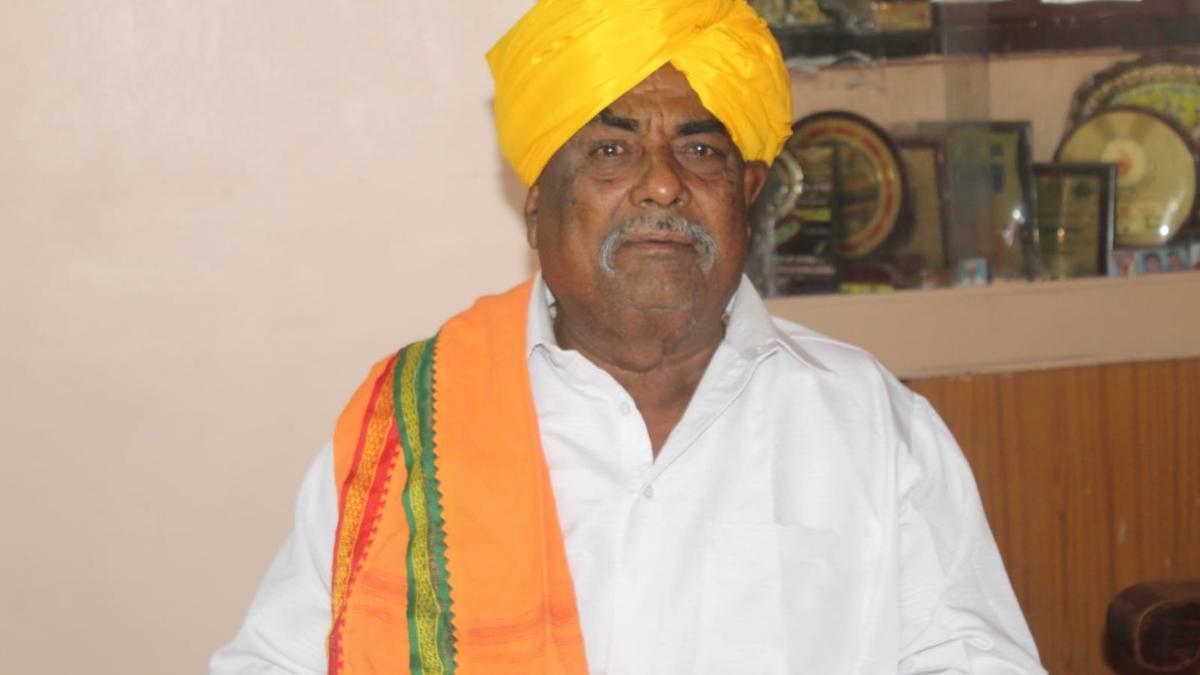It is not difficult to find the house of Venkappa Ambaji Sugatekar, the veteran Gondhali artist. One has to get down at the Nava Nagar Bank Circle and ask for directions to the house of the Padma Shri awardee. The people of the area are very proud of ‘Gondaliger Yankappa’ living amidst them. A young shop-keeper pulls down the shutters and walks you to his house.
The first thing one notices about the man who received the Padma award for his contribution to the folk art form is how fit he is. At 82, he walks upright, remains free of most lifestyle diseases, his hearing is intact, and he does not need spectacles. A few minutes into the conversation with him, you are floored by his elephantine memory and the wide knowledge base.
The real treat, however, is seeing him perform. His high-octane voice is captivating. He has a wide range and uses varied styles for different types of songs — Bhajans, Abhanga, Dasara Pada and Lavani. He seems to effortlessly switch between his singing voice and normal voice, when he stops to tell mythical tales.
A typical Gondhali (or Gondala in districts like Bagalkot and Vijayapura) performance lasts for around five to seven hours. It starts with the first aarati around 9.30 p.m. and ends at daybreak with the fifth aarati. The artists start by singing praises of deities Amba Bhavani and Saundatti Yallamma.

Venkappa Ambaji Sugatekar with his family memebers at his home in Bagalkot. | Photo Credit: SPECIAL ARRANGEMENT
A bouquet of several flowers
The first tale is that of warrior god Parashurama and his mother Yallamma. It describes how sage Jamadagni ordered Parashurama to kill his mother for being distracted by a pair of fish. Parashurama obeyed him without question, but came to seek his mother’s life as the reward for taking it. Years later, when a greedy king killed his father, Parashurama toured the earth to rid them of Kshatriyas. The myth goes that the Chandevu or Tuntun, the drum used by Gondhali singers, was first made by Parashurama with the emptied skull of an evil king. It is now made of wood and seasoned leather.
His performances tend to be bilingual as he is proficient in Kannada and Marathi. The stories include those of Amba Bhavani and Ma Kaali, Sati Anasuya, Satya Narayana’s grace and Lord Shiva’s battle with his father-in-law, Daksha Prajapati. He drifts to Marathi folklore and Warkari songs. He sings of the Pandhara Pura Vithala, and his devotees like Namdev- Eknath-Tukaram, Chokha Mela, and others. He then starts singing the songs of Purandara Dasa praising lord Vithala.
Modern tales of the battles of Shivaji Maharaj, Tanaji Malsure and those of India’s freedom struggle are also featured. Some stories are weaved around characters like Gandhiji and Netaji Bose, while others are about Ramakrishna Paramahansa and Swami Vivekananda.
Venkappa never went to school. But his childhood training experience over the decades have made him a master story teller. He recalls over 1,000 songs and 150 tales. He sings folk songs, Dasara Pada, ballads of Shishunala Sharif, Vachana Sahitya, Tatva Pada and Devi Pada.

Neighbours and family members welcome Venkappa Ambaji Sugatekar, Gondhali singer after his return from a performance following the announcement of the Padma Shri award for him. | Photo Credit: SPECIAL ARRANGEMENT
Shaped by the world around
He gives lessons on communal harmony, about the need to protect and empower women, of sending children to school and about non-accumulation of wealth. Where did he develop this world view?
“You tend to pick it up along the way. I observed that during my father’s time, all Gondhali artists were the same and told the same tales. I decided to include everyday lessons in my performance. I used to ask my children to read aloud newspapers and listen to the radio,’‘ he said.
Over the years, Venkappa seems to have learnt to not think much of the compliments he gets. “People say my voice is good. Do they know how I got it? It was perfected during our tours around the village, begging. As young children, my brothers and I would go around singing and seeking alms. We had to sing in loud voices to attract the housewives working in the kitchen or backyard. How else would the women notice us?’‘ he jokes.
Early life and hardship
Born to Ambaji, a poor Gondhali artist from the Bagalkot old city, he was raised in the midst of songs and Puranic tales, the stories of Chhatrapati Shivaji Maharaj’s valour and the affection of Yallamma. Ambaji had seven children and struggled to provide for his family, as the performances were restricted only to five months a year.
At the age of 10, Venkappa climbed the stage as an accompanying artist to his father and elder brother Hanumanthappa. The tragic death of Hanumanthappa in his youth was a big blow. And all the siblings were forced to go on singing tours to earn.
The family was landless, but lived in a kutcha house built on half-a-gunta donated by a land owner in old Bagalkot. But the area was submerged in the backwaters of the Almatti dam in the 1980s. A few years later, they were given a 600 square feet plot in new Bagalkot. The joint family now lives in a small house on that plot. Venkappa’s five siblings and their children are all Gondhali artists. Venkappa’s children Hanumanth and Ambaji are both young performers. Their children are in school and are not sure if they would take up the hereditary occupation.
The practice of organising Gondhali performances is prevalent among several communities, but the singers tend to come from a single caste group, which has now come to be known as Gondaligeru or Gondhali Samaj. It is an umbrella term for around 90 Bedagu or sub-castes. However, the singers tend to be from only seven sub-castes. Gondhalis rarely marry outsiders, though inter-marriage among sub-castes is allowed. They are listed among Other Backward Classes in Karnataka.
“It is said that during Shivaji Maharaj’s time, there were Gondhali singers from Maratha, Panchal and even Brahmin communities. But now, it has remained restricted to one community,’‘ Venkappa said.
Venkappa has bitter memories of his childhood. “During the overnight performances, people appreciated our singing and even fell at our feet. But the next morning, when we went seeking food, they would throw it at us. We were not given water in cups. We were asked to hold out our palms to drink water as we were seen as meat-eaters who would defile the cups. However, a lot has changed now a days,’‘ he said. “As a young man, I used to be always upset at such discrimination. But my uncle told me that caste was not created by God, but by man. It did not mean much then, but now I have begun to fully appreciate it.”
He believes that though a Gondhali artist is trained by his parents or relatives, learns the songs and tales by heart to recite them at will, a really good artist is one who improvises. “He has to pick stories from his surroundings. He has to turn anecdotes and happenings in his city into moral stories. Some artists use newspaper articles in their performances,’‘ he said.

Venkappa Ambaji Sugatekar, sings during the Bharat Hunnime festival at his home in Bagalkot. | Photo Credit: SPECIAL ARRANGEMENT
Bleak future of art
But Venkappa is not very hopeful of the future of the art form. “If Gondhali art were to vanish tomorrow, it is not because there is no audience, but because there will be no performers. People think that Gondhalis artistes are blessed beings who sing bhajans. They do not realise that we are human beings with families to raise. There is high regard for the art, but no remuneration,’‘ he said. He recalls performing for five fistfuls of rice or three coconuts. “Now people pay cash. Some of them are very liberal and pay more money than we expect. But some pay so little that it does not match our bus fare,’‘ he said.
He feels the Union and State governments should take steps to protect and preserve the art. “The honorarium to senior artistes is just around ₹2,000 per month. It should be revised. They should also be entitled to some benefits, like travel allowances and subsidies, health insurance, and low-cost housing. The Union Government should organise more cultural programmes and set up a Gondhali academy to train young artistes,’‘ he said.
At one time, every Gondhali man trained to be a singer and performer. “That may be because we had no education, owned no land nor did we have capital or the acumen for business. However, the situation is different now. Most of our children are educated. Some boys and girls are taking up jobs in schools and anganwadis, some have even joined private companies and banks as clerks. Hard times have forced senior artistes to discourage their children from embracing Gondhali art. The demand for Gondhali performances has not decreased. Instead, it has increased. However, there are not enough performers,” he said.
Recognition
The Karnataka Folklore University recognised his talent and presented him with a honourary doctorate. The university citation says that Venkappa has dedicated over 70 years to performing Gondhali folk music and storytelling and trained over 1,000 students free of cost, ensuring the transmission of Gondhali tradition.
In his Mann Ki Baat address, Prime Minister Narendra Modi praised Venkappa. He spoke of his life long efforts in reviving and sustaining Karnataka’s folk traditions. Modi described him as a “cultural torch bearer” who has dedicated his life to preserving India’s rich cultural heritage. He was also invited, along with his sons, to watch the Republic Day parade in New Delhi.
Published – February 21, 2025 11:08 am IST


